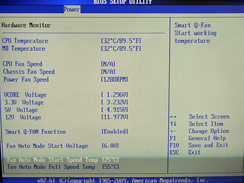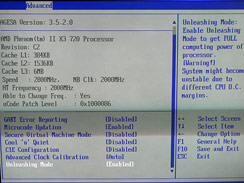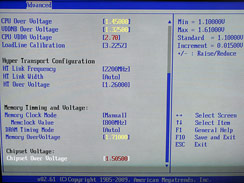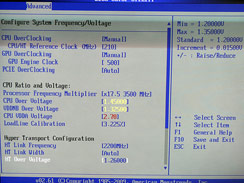BIOS
Asus includes the usual, very useful Easy Flash 2 facility, but stops short of including BIOS profile saving. Instead Asus includes ExpressGate - the 'instant on' embedded Linux system that may or may not be useful to you. Fan control has been improved - now it offers a start voltage and target temperature, rather than just "silent" or "optimal".The 'unleashing mode' you can see in the bottom left hand picture is the option which allows you to unlock the extra cores on certain AMD CPUs. In order to do this, ACC must be set to auto first. It's hidden at the bottom of the CPU Features submenu.
As usual Asus lays out the BIOS options for overclocking very well, and the sub-divisions on the page are natural breaks to help find everything easier. The BIOS voltage options are numerous and afford fine changes where necessary: there's plenty of voltage for the 785G northbridge, CPU, HyperTransport and memory, but strangely nothing for the CPU-NB. No clock option, no voltage change.
There's also overclocking and voltage options for the Sideport DDR3 memory too, however these are brushed away from the rest of the options above into another sub-directory.
Testing Methods
With the exception of SiSoft Sandra and Lavalys Everest, all of our benchmarks have been engineered to give you numbers that you are likely to find useful when actually using the products we have evaluated in the real world.We are also focusing a lot more of our time on evaluating the stability of the motherboards (and platforms) using a stress test designed to highlight any of the potential weaknesses that the product may have. That involves a gradually increasing amount of stress starting with Prime95 torture test on all cores and expanding to a looping 3DMark06. This is to ensure that all parts of the system are stressed simultaneously over a period of time.
We believe that the consumer is never likely to subject their platform to this level of stress and we are not expecting every product to complete an entire extended stress test. However, most poorly engineered products fail within the first couple of hours, or even minutes, allowing us to make a conscious decision on whether a motherboard (or platform) is worth your money, regardless of how well it performs in our benchmarks.

Test Setup:
Motherboards:
- Asus M4A785TD-V Evo (AMD 785G/SB710 0211 BIOS)
- Gigabyte GA-MA785GMT-UD2H (AMD 785G/SB710 F1 BIOS)
- Asus M4A78-HTPC (AMD 780G/SB700 0506 BIOS)
Common Components:
- AMD Phenom II X3 720 Black Edition (3x2.8GHz)
- 4GB Corsair DDR3 PC12800 CL9
- PC Power and Cooling Silencer 750W PSU
- Seagate 7200.11 1TB SATA hard drive
- Intel X25-M 80GB SSD
- Windows Vista Home Premium 64-bit SP1
- ATI Catalyst 9.7 WHQL
Overclocked Settings
- Asus M4A785TD-V Evo: 4x3.57GHz (230MHz x 15.5) CPU, 2.3GHz CPU-NB, 1,600MHz memory, 7-8-7-20-40-1T. 785G core clock increased from 500MHz to 750MHz.
- Gigabyte GA-MA785GMT-UD2H: 4x3.5GHz (15.5 x 226MHz HT) CPU, 2.26GHz CPU-NB, 1,506MHz DDR3 at 8-8-8-20-1T. 785G core clock increased from 500MHz to 700MHz.
- Asus M4A78-HTPC: 3x3.485GHz, (17 x 205MHz CPU), 2.0GHz NB, 1,093MHz DDR2 at 5-5-5-18-2T. 780G core clock increased from 500MHz to 700MHz.

MSI MPG Velox 100R Chassis Review
October 14 2021 | 15:04
















Want to comment? Please log in.